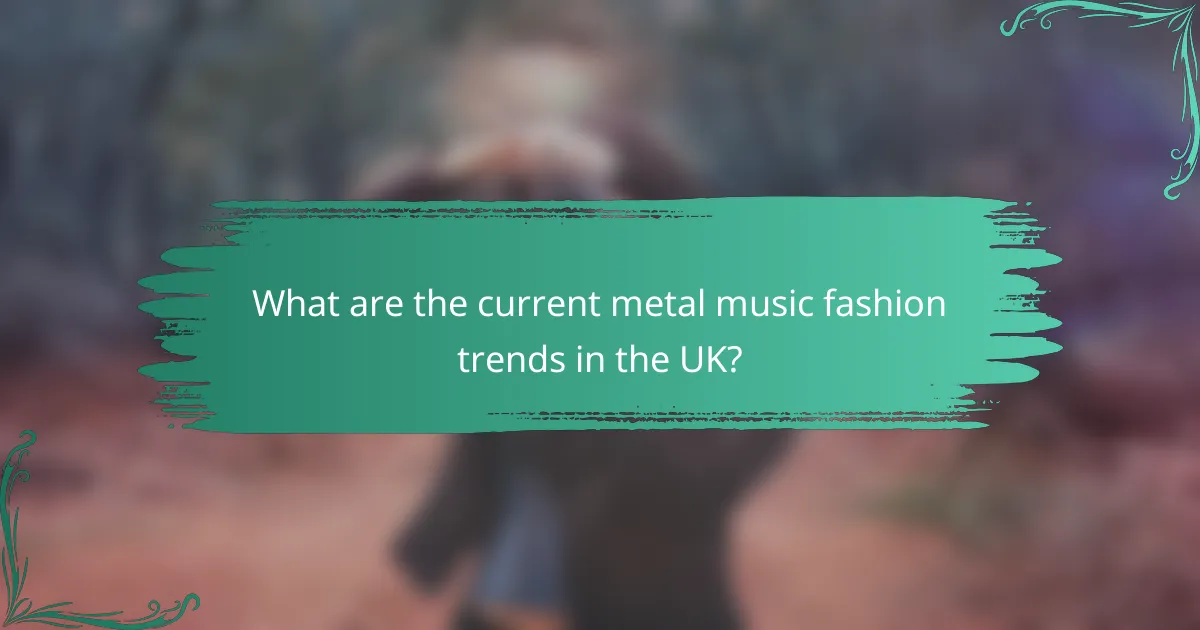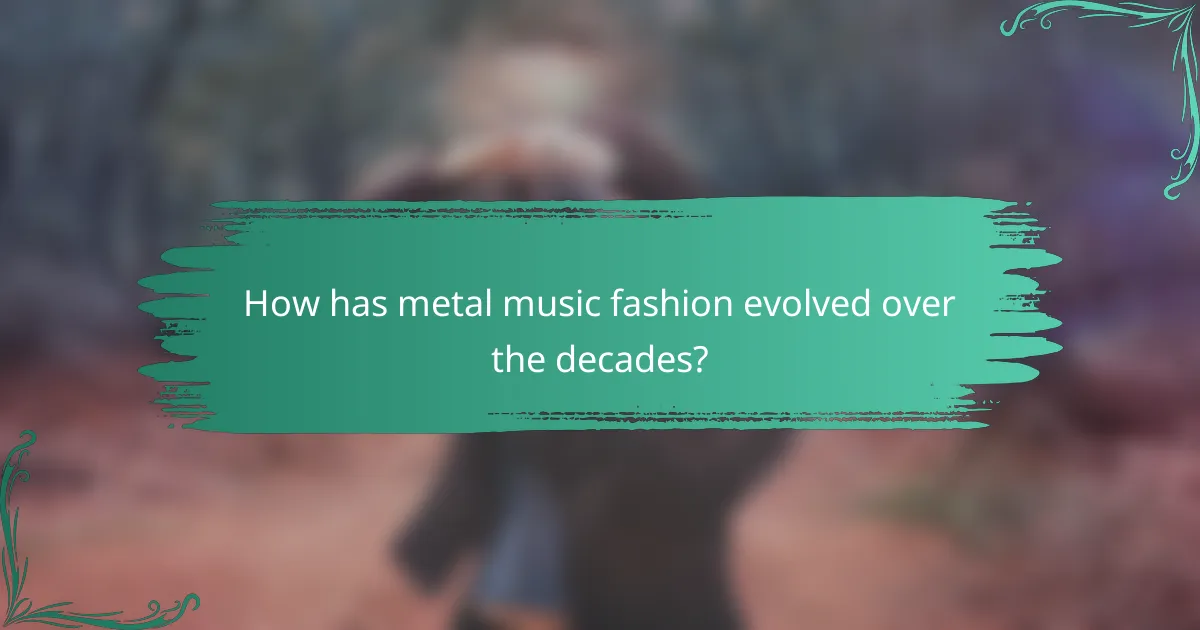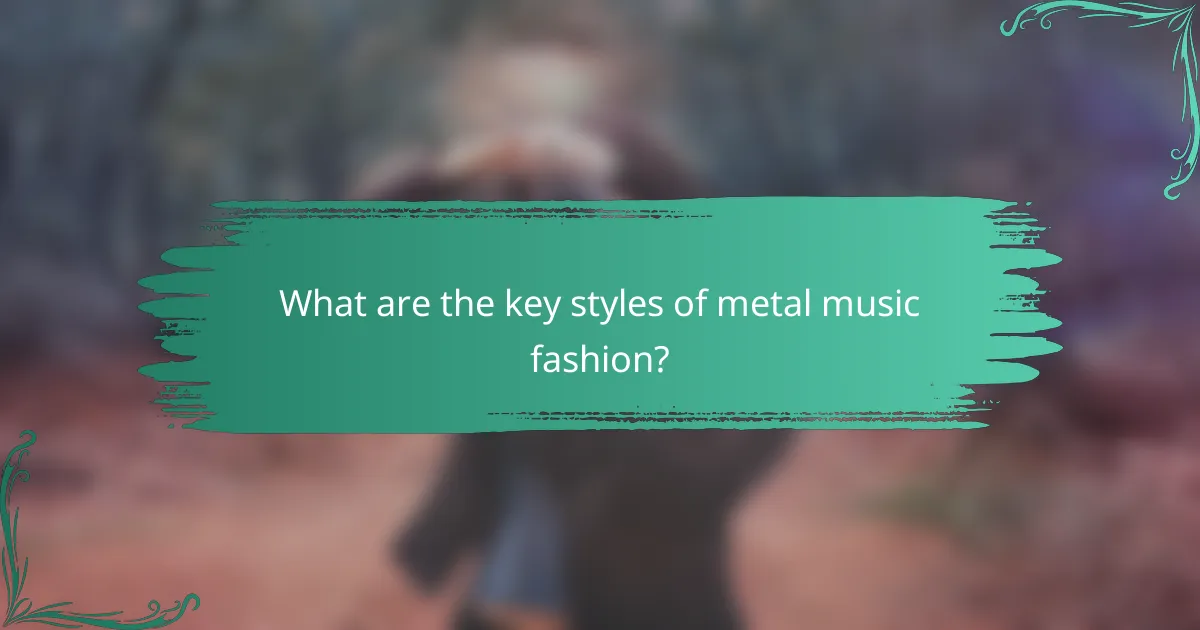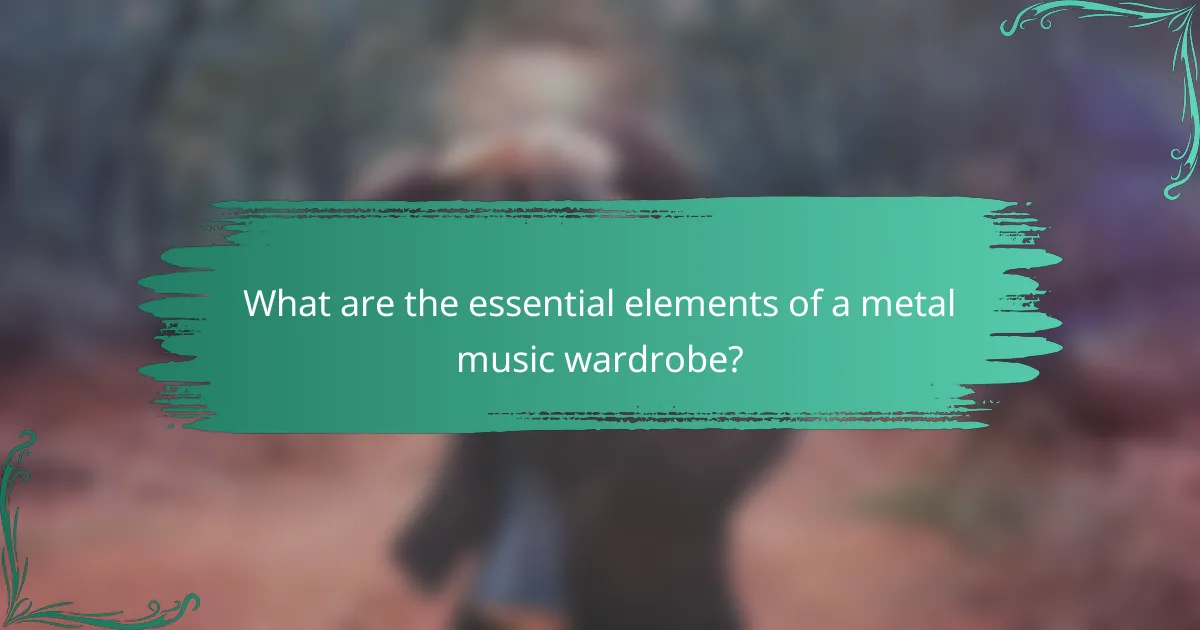Metal music fashion is a vibrant expression of the genre’s rebellious spirit, evolving significantly since its inception. Each decade has introduced unique styles, from classic heavy metal to thrash and black metal, reflecting the diverse subcultures and societal influences that shape the identity of both musicians and fans. Today, trends in the UK blend traditional elements like leather jackets and band t-shirts with modern interpretations, creating a dynamic fashion landscape within the metal community.

What are the current metal music fashion trends in the UK?
The current metal music fashion trends in the UK emphasize a blend of classic styles and modern interpretations. Key elements include leather jackets, band t-shirts, and a variety of accessories that reflect the genre’s rebellious spirit.
Leather jackets and band tees
Leather jackets remain a staple in metal fashion, serving as a symbol of rebellion and toughness. Often adorned with patches or studs, these jackets can be found in various styles, from classic biker cuts to more tailored fits.
Band t-shirts are equally essential, showcasing favorite artists and albums. They are typically worn oversized for a relaxed look, and pairing them with a leather jacket creates a quintessential metal outfit.
Combat boots and distressed jeans
Combat boots are a popular footwear choice in the metal scene, offering durability and a rugged aesthetic. Brands like Dr. Martens are favored for their quality and style, making them a go-to option for many metal fans.
Distressed jeans complement the overall look, often featuring rips or frayed hems. This combination of boots and jeans not only provides comfort but also aligns with the gritty vibe of metal music.
Accessories like spikes and chains
Accessories play a crucial role in metal fashion, with spikes and chains being particularly prominent. Spiked bracelets, collars, and belts add an edgy touch to any outfit, enhancing the rebellious image associated with metal culture.
Chains can be used as decorative elements or functional accessories, such as wallet chains. When incorporating these items, balance is key to avoid overwhelming the overall look while still making a bold statement.

How has metal music fashion evolved over the decades?
Metal music fashion has undergone significant transformations since its inception, reflecting the genre’s diverse subcultures and societal influences. Each decade introduced distinct styles that shaped the identity of metal musicians and fans alike.
1970s: Birth of heavy metal style
The 1970s marked the emergence of heavy metal fashion, characterized by a raw and rebellious aesthetic. Bands like Black Sabbath and Led Zeppelin popularized leather jackets, tight jeans, and band t-shirts, setting the groundwork for future styles.
Accessories such as chains, studs, and long hair became synonymous with the metal look, emphasizing a rugged and anti-establishment attitude. This decade laid the foundation for the visual identity of metal music, blending elements of rock and counterculture.
1980s: Glam metal and excess
The 1980s saw the rise of glam metal, which introduced a flamboyant and extravagant style. Bands like Mötley Crüe and Poison embraced bright colors, spandex, and heavy makeup, creating a stark contrast to the previous decade’s grittiness.
Hair became a focal point, with big, teased hairstyles dominating the scene. Accessories such as bracelets, earrings, and platform shoes were common, reflecting the era’s emphasis on excess and theatricality in both music and fashion.
1990s: Grunge and alternative influences
The 1990s brought a shift in metal fashion as grunge and alternative influences emerged. Bands like Alice in Chains and Soundgarden incorporated a more laid-back style, favoring flannel shirts, baggy jeans, and combat boots over the glam aesthetic.
This decade emphasized authenticity and comfort, moving away from the flashy looks of the 80s. The blending of metal with grunge created a unique fashion statement that resonated with a generation seeking a more grounded identity in music and style.

What are the key styles of metal music fashion?
Metal music fashion encompasses a variety of distinctive styles that reflect the genre’s diverse subcultures. Key styles include classic heavy metal, thrash metal, and black metal, each with unique characteristics and aesthetics.
Classic heavy metal style
Classic heavy metal style is characterized by leather jackets, band t-shirts, and denim. This look often features patches and studs, showcasing allegiance to favorite bands and a rebellious spirit.
Accessories play a significant role, with items like fingerless gloves, chains, and combat boots completing the ensemble. The color palette tends to be dark, with black being predominant, but also includes metallic shades and vibrant colors representing band logos.
Thrash metal aesthetics
Thrash metal fashion is known for its aggressive and energetic vibe, often incorporating elements of punk. Baggy jeans, oversized t-shirts, and sneakers or skate shoes are common, reflecting a more casual approach.
Graphic prints and DIY elements, such as ripped clothing and customized patches, are prevalent. The style emphasizes comfort and movement, suitable for the fast-paced nature of thrash music.
Black metal and its unique look
Black metal fashion is distinctively dark and theatrical, often featuring black clothing, capes, and corpse paint. This style aims to create a haunting and otherworldly appearance, aligning with the genre’s themes.
Accessories may include spikes, leather, and elaborate jewelry, enhancing the dramatic effect. The emphasis on individuality and artistic expression is crucial, with many fans customizing their looks to reflect personal interpretations of the music.
![]()
Which iconic bands influenced metal fashion trends?
Several iconic bands have significantly shaped metal fashion trends, each bringing their unique style and imagery to the forefront. Black Sabbath, Metallica, and Iron Maiden are among the most influential, with their aesthetics reflecting the themes and attitudes of the metal genre.
Black Sabbath’s dark imagery
Black Sabbath is known for its dark and ominous imagery, which has heavily influenced metal fashion. Their use of gothic elements, such as skulls and occult symbols, has inspired fans to adopt similar motifs in their clothing and accessories.
Typical attire includes black leather jackets, band t-shirts featuring dark artwork, and accessories like chains and spikes. This style emphasizes a rebellious attitude, resonating with the themes of their music.
Metallica’s casual yet edgy style
Metallica’s fashion combines casual wear with an edgy twist, making it accessible yet distinctive. Their signature look often includes denim jackets, graphic tees, and combat boots, which reflect their heavy sound and lifestyle.
Fans can emulate this style by mixing band merchandise with everyday clothing, such as pairing a Metallica t-shirt with ripped jeans. This approach allows for personal expression while staying true to the band’s aesthetic.
Iron Maiden’s iconic album art apparel
Iron Maiden is renowned for its striking album art, particularly the character Eddie, who has become a symbol of the band. This iconic imagery is frequently featured on t-shirts, hoodies, and other merchandise, making it a staple in metal fashion.
Wearing Iron Maiden apparel not only showcases a love for the band but also connects fans to the rich visual history of metal music. Incorporating album art into outfits can create a bold statement while celebrating the band’s legacy.

What are the essential elements of a metal music wardrobe?
A metal music wardrobe typically includes bold and edgy clothing items that reflect the genre’s rebellious spirit. Key elements often consist of band merchandise, layered outfits, and distinctive hairstyles that together create a cohesive metal aesthetic.
Band merchandise and logos
Band merchandise is a cornerstone of any metal wardrobe, showcasing allegiance to favorite groups. T-shirts, hoodies, and patches featuring iconic logos or album art are popular choices, often worn to concerts or casual outings.
When selecting band merchandise, consider the quality of the fabric and the fit. Authentic items from official band stores or reputable retailers ensure longevity and support the artists directly.
Layering with vests and hoodies
Layering is essential in metal fashion, with vests and hoodies serving as versatile staples. A denim or leather vest can be paired with a band tee, while a hoodie adds warmth and a relaxed vibe, perfect for outdoor events.
Mixing textures and styles can enhance your look; for instance, combining a graphic hoodie with a studded leather vest creates a striking contrast. Aim for a balance between comfort and style to maintain the edgy essence of metal fashion.
Signature hairstyles and makeup
Hairstyles and makeup play a significant role in defining a metal look. Long hair, often worn loose or in braids, is a classic choice, while shorter styles can feature bold colors or spikes for a more modern twist.
Makeup can range from subtle to dramatic, with dark eyeliner and bold lip colors commonly used to complement the overall aesthetic. Experimenting with different styles allows for personal expression while staying true to metal roots.

How do regional variations affect metal fashion?
Regional variations significantly influence metal fashion, shaping styles through cultural, historical, and musical contexts. In different parts of the world, local trends, climate, and subgenres contribute to distinct fashion statements within the metal community.
Differences between American and European styles
American metal fashion often emphasizes a more casual and rebellious aesthetic, with band t-shirts, denim jackets, and cargo pants being staples. This style reflects the roots of metal in rock and punk culture, showcasing a laid-back yet edgy vibe.
In contrast, European metal fashion tends to incorporate more elaborate and theatrical elements. Many European metalheads favor leather jackets, spikes, and accessories that reflect the darker themes of genres like black metal and gothic metal. This can include intricate designs and a more polished appearance, often influenced by local fashion trends.
Additionally, the climate plays a role; for instance, northern European countries may see heavier use of layers and warmer materials compared to the lighter fabrics preferred in warmer American regions. Overall, understanding these differences can help fans express their identity within the global metal scene.
